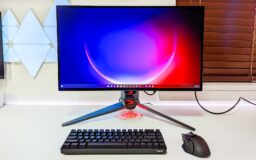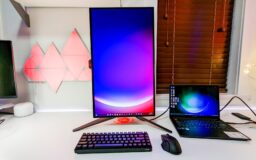
Today I will be reviewing my first OLED monitor the ASUS ROG Swift OLED gaming monitor (PG27AQDM). Since the first time OLED displays were introduced on mobile phones I was hooked. I absolutely loved the deep blacks and the vibrant colours that OLED displays produced. Ever since then, I’ve always dreamed of having OLED displays on everything, from my TV’s to computer monitors.
In this review I’ll be talking about the monitor’s design, ergonomics, connectivity, panel, gaming performance, and of course sharing my final thoughts.
ASUS ROG Swift monitor design
Out of the box it’s clear that the ROG Swift OLED is made for gamers. ASUS has a specific design aesthetic for all of its gaming peripherals. They have bold, sharp angles, ROG logos, and eye-catching LEDs.
In the case of the ROG Swift OLED, one of the first things you’ll notice after you set it up is the bright red ROG logo that’s projected onto your desk from the bottom of the monitor stand. On the monitor itself you’ll find more LEDs. The first is on the bottom center of the monitor where you’ll see another red LED ROG logo.
Finally, when you turn your attention to the back of the monitor you will find another large ROG logo. This logo is backlit with RGB LEDs that have customizable behaviours. Along the back of the monitor stand you will also see the word “SWIFT” lit up in red.

ROG Swift monitor ergonomics and adjustments
The ASUS ROG Swift OLED has fantastic ergonomics that you would expect from a premium monitor like this. With the monitor stand you can adjust height, pivot, and tilt forwards and backwards as well as swivel left and right. You can also rotate the monitor 90 degrees into portrait mode.
The ROG Swift OLED can easily be removed from the monitor stand thanks to the quick release latch. For those that like to mount their monitors, the ROG Swift is also VESA compatible.
Overall, I found the ASUS ROG Swift OLED ergonomics to be perfect for my gaming, media, and day-to-day productivity needs.

Intuitive controls
On the bottom front of the ASUS ROG Swift OLED behind the ROG logo you will find three buttons. These buttons are the back button, navigation joystick, and the power button. The back button and navigation joystick are the primary buttons used to control the monitor’s On-Screen Display (OSD).
Within the OSD ASUS offers a number of gaming related features. This includes an on-screen FPS counter, crosshairs for first person shooter games, and monitor presets based on the type of game played.
Looking further into the monitor’s OSD you will also find controls for the monitor’s LEDs. Like I mentioned earlier, only the back panel of the monitor has RGB LEDs. You can use the OSD to customize the RGB behaviour to your liking. Controls for the other LEDs are limited. You’re only able to customize the brightness of the downward facing LED at the base of the monitor stand.

ASUS ROG Swift OLED connectivity
When it comes to connectivity ASUS made sure that users would have plenty of options. Along the bottom of the monitor you will find 1x display port, 2x HDMI 2.0, 1x earphone jack, and 2x USB-A 3.2 ports.
During my testing this was more than enough ports for me to connect multiple laptops to the monitor. If I could make one request to ASUS, it would be to add a USB-C thunderbolt port. All of my laptops use USB-C and being able to connect to a monitor via USB-C would eliminate the need for dongles.
ROG Swift’s gorgeous OLED panel
The panel on the ASUS ROG Swift OLED is one of the best I’ve seen. OLED panels are known for their deep blacks and superbly vibrant colours. My test unit has a 26.5” panel with a resolution of 2560 x 1440 pixels. Gamers won’t be disappointed in the ROG Swift’s incredible speed, the panel has a refresh rate of 240Hz and a response time of 0.03 milliseconds.
Visibility on this panel is equally as impressive. According to ASUS’ website, the ROG Swift OLED has a viewing angle up to 178 degrees. I tested this claim and was impressed, I was able to clearly see the text and images displayed regardless of what angle I was viewing at.
ROG Swift gaming and media performance
Gaming on the ASUS ROG Swift OLED is incredible. This is due to the OLED technology which produces a higher contrast ratio and more vibrant colours. In my testing I played some of my favourite games including Call of Duty Warzone 2 and Halo Infinite. The fast refresh rate and response time of the ASUS ROG Swift OLED is perfect for these fast paced games.
During my testing I didn’t experience any screen tearing or stuttering. This is because the ROG Swift OLED is compatible with NVIDIA’s G-Sync and AMD FreeSync. This technology allows the monitor to match the frames per second (FPS) displayed from my computer’s graphics performance unit (GPU). The result is a clear image without any distortions.
The ASUS ROG Swift OLED is also HDR10 certified and can achieve up to 1000 nits of brightness. This is another certification that amplifies your gaming and media performance. The reason for this is that HDR10 enhances the visual quality of games and media by providing a wider range of colors, higher contrast, and brightness.
Overall, playing games and consuming media on the ASUS ROG Swift OLED is fantastic. The large 26.5″ screen is also a good size for total immersion while playing games and consuming media. I couldn’t be more impressed with the monitor’s visuals and performance.

Productivity on the ROG Swift OLED monitor
Over my time testing the ASUS ROG Swift OLED I used it as my primary monitor for my day-to-day work. Like playing games and watching media, doing work on the monitor was equally as captivating. Icons, images, and text seemed to have a new life and popped out at me as I worked. When I had video calls, all of a sudden the typically bland looking quality images had amazing contrast and saturated colours.
As mentioned earlier, the ROG Swift OLED monitor is capable of rotating 90 degrees into portrait mode. This mode is great for designers, artists, programmers, or anyone else that finds themselves needing more vertical visibility. In my case, I used this mode for photo editing and reading documents.

Final thoughts on the ASUS ROG Swift OLED gaming monitor
The ASUS ROG Swift OLED (PG27AQDM) is by far my favourite gaming monitor. It’s fast, responsive, has great ergonomics, plentiful connectivity, an eye catching design, and of course a gorgeous OLED display. The high resolution and ability to rotate into portrait mode also means that this monitor is great for creative and productivity professionals. For those of you looking for something a little larger the ASUS ROG Swift OLED also comes in a 47.5″ variant. Personally, I find the 26.5″ panel to be perfect as an all-round monitor.
If you’re looking for a gaming monitor I highly recommend checking out the ASUS ROG Swift OLED. This monitor has everything you need to enjoy your games, movies, and even casual web browsing or work.
If you’d like to see what other gaming peripherals are made by ASUS you can have a look here.
 Note: The ASUS ROG Swift OLED monitor is currently on pre-order until June 9th when it can be purchased both online and in store. For anyone purchasing in store, the monitor will come with a ROG pillow (while quantities last).
Note: The ASUS ROG Swift OLED monitor is currently on pre-order until June 9th when it can be purchased both online and in store. For anyone purchasing in store, the monitor will come with a ROG pillow (while quantities last).




A 240Hz refresh rate is the most important feature to me. Smooth matters !
The fast refresh rate and response times, would benefit my gaming performance.
The most important feature for me is the monitor’s ergonomics and adjustment. Having the capability to rotate the monitor into landscape or portrait is really helpful for me as a programmer since I can read more code on one page.
The most important feature for me was the refresh rate and the most important look to me was the red bright led on the bottom.
Having that 240Hz OLED display would be pure butter. Beautiful display and would make gaming so much clearer and faster.
I care about smoothness the most, so the 240 Hz refresh rate is most important feature.
The 240Hz refresh rate is the most important feature to me. The smoother the game action is, the better gaming experience.
The OLED panel to have a refresh rate of 240Hz.
240Hz refresh rate is the most important feature, since it will result in faster and better gaming experience
Several years ago (like 7 now, oh wow.. feels like only 3) I upgraded my monitor from a 2007 dell low-mid tier potato to a newer but still cheap 144hz tn display (a mistake, I now realize); although it’s an improvement over the dell, I yearn for better visuals and fidelity.
Recently I built a whole new rig – sparing few expenses in the hardware. My new 3080 is begging for a challenge, and 240hz at an incredible 2560×1440 resolution would begin to put its through its paces.. and I can only imagine the beauty of the picture; it would probably increase my pc usage 3 fold. I can’t even fathom a response time of 0.03ms when my potato supports a measly 10ms response, and isn’t even the magical new OLED tech I’ve only been able to window shop as of recent times.
The next piece of my pc to be upgraded is my monitor, and I’d be grateful if ya’ll could help a homie out so that the would-be monitor budget can instead be siphoned into the headphones and peripherals fund (all to be ASUS of course – the GOAT) 😉
Thanks for the in depth review – the info will be helpful for my future monitor shopping. But let’s be honest, there won’t really be any shopping done, because ASUS is the only answer. The only question that remains is… how big?
The most important feature for me is the ergonomics and adjustments, which would enable me to play longer in better comfort
I think the OLED panel is a difference changer on this ASUS ROG Swift OLED gaming monitor (PG27AQDM). We have seen a lot of the same old panel types (TN, VA, IPS) being used over and over on monitor releases. A OLED panel would certainly be a game changer in the monitor panel space.
I’d say the fact that its an OLED panel is my most important feature, but that’s not to say I don’t appreciate and love the other specs like it being 1440p, for that extra bit of sharpness. 1440p in my opinion is the perfect balance. It provides that extra sharpness over 1080p, but is not as demanding as 4k. And of course, can’t forget the 240Hz smooth goodness. Makes for buttery scrolling, and smooth gameplay
The OLED panel would be the most important for me, to give me the deep black and vibrant colours.
While a new Asus 26.5″ monitor would be a great upgrade,, I have to admit that I interested in seeing my gaming on a 47.5″!
The most important feature for me is the gaming performance. Makes a huge difference when you can play with a proper frame rate.
ROG Swift monitor ergonomics and adjustments is the most feature Marucus discussed as good ergonomics reduces the strain on neck and allows you to game longer.
The 240Hz refresh rate is the most important feature to me. The smoother the action, the better !
The ergonomic adjustments are vert important, to help lengthen my play time.
Having a bigger screen is nice, especially with the OLED panel, good clarity, 0.03ms on a 240hz monitor, also 1440p, in my case this would be a lot better then my 1080p monitor. In the end nice to see new tech on the market.
Most important feature for me is by far the 240Hz refresh rate so my fast motions will be smooth as butter!!!!
I think the most important feature Marcus highlighted is the ergonomics and that they work for media, gaming, and productivity
Having switched from 60Hz to 165Hz recently, having a high refresh rate is important for a lot reasons
Too often missed: The intuitive controls! So many monitors have horrible, frustrating controls that basically boil down to trial and error to change a setting. There are a lot of great monitors out there, but not many with good controls. With this monitor, you can adjust the settings while gaming without skipping a beat
I recently upgraded to 165hz monitor from 75hz monitor. As smooth as I thought it would be, unfortunately it isn’t. There is much ghosting and the colors are pale. I did not realize that my previous Asus 75hz monitor had an IPS panel even though lower refresh rate. For all such reasons, getting a monitor like this would be the highest upgrade I would ever experience in my 15years of Gaming.
The OLED display is the most important feature as i have an artist eye and will take pleasure in a better visual.
Most important feature is the OLED panel for superior refresh rates and contrast. This will allow me to game with the best picture quality and smoother gameplay than LCD.
OLED with HDR10 certification is the most important. Though the flashy LED’s and lighting on the monitor itself is great for conversation starters, the whole point of the monitor is visuals when gaming or using for media.
The OLED panel is the coolest feature for me.
Absolutely love these OLED monitors, the response times are by far the biggest leap for monitors in years, combined with the refresh rate it will really help with motion sickness I get in gaming on a poor quality monitor. I should also mention I love the fact that they use VESA compliant mounts for their stands, and after dealing with a certain other manufacturers’ offering without them, I really appreciate just how much easier those make using a monitor.
The most important thing about this monitor that would benefit me and my setup is a tie between the connectivity and productivity, though I’d have to say that productivity takes the point because I use my setup for work, I do Voice acting and gaming, sometimes both are discussed for doing in character gaming sessions.
The most important feature that Marcus discussed is the productivity. Aside from gaming I am also doing other things like work andmovie and I would like to see if it will affect something since this is an oled monitor.
The most important feature that Marcus discussed that will benefit my gaming performance is that gorgeous OLED Display. With a refresh rate of 240Hz and a response time of 0.03 milliseconds not only will things respond faster but look amazing.
I think the most important feature is the 240Hz refresh rate which helps for smooth playing no matter what game you are playing
The deep blacks and vibrate colours are great and needed to see all the various details in games. Especially when playing mystery/crime solving games and you need to see all the details.
I like the monitor presets for the type of game played. It makes adjusting between games easier.
The 240Hz refresh rate is the most important feature. Great for the smoothest gaming experience.
The most important feature is the gaming performance, as I would use this to play Witcher 3. I love that during his testing he didn’t experience any screen tearing or stuttering
Ergonomics! I’m pumped to have a monitor I can finally adjust the angle and not be locked into whatever the manufacturer setup.
“Crosshairs for first person shooter games,” would help with my aim.
Not the flashiest thing but I’d like the ergonomic flexibility, even being able to go to portrait for some work purposes.
gotta be the deep blacks and the vibrant colours of the OLED
Wow this OLED panel has a better refresh rate and response time than my current IPS
I’d love to have a monitor with true blacks!
I think the OLED panel is an important feature due to its refresh rate and colours!
Fast refresh rate and response times will help a slow poke like me
For me, being able to reorient the monitor on the fly is critical. I would love to work on some photo edits in portrait mode.
The OLED panel itself is the best feature because of the superior picture quality.
The refresh rate looks great!
most important feature for me discussed is the OLED panel because I am all about the pictures and with this panel, I can see everything in high res, high refresh rate and best angles
Comments are closed.